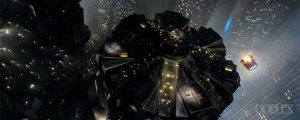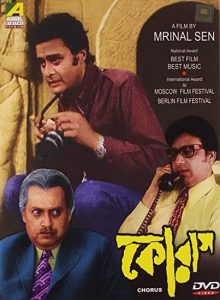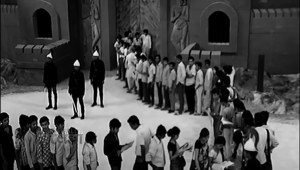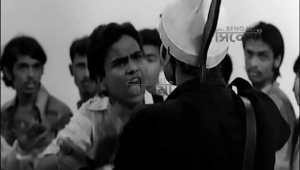
A Cyberpunk Chorus
An Article by | Sayantan Mukherjee
Mrinal Sen has always been regarded as one of the finest filmmakers of India, even the world. His contributions to cinema remain unparalleled in their documentation of Indian society and his experiments with the form of cinema will continue to inspire generations of film scholars and film makers to take an objective view at film making itself. Sen, inspired by Jean Luc Godard in no less measure, understood that cinema needs to abandon its strict classical nature and become an entity which constantly provokes and pokes at the audience to sit up and take notice. He experimented with various stylistic elements of freeze frames, jump cuts, fragmented narratives, breaking the fourth wall, incorporating actual footage of rallies and processions in a fictional narrative and many more. When other filmmakers were honing the traditional way of film making, Sen was experimenting with diverse story telling possibilities. He introduced “New Wave” into the Indian context with his film Bhuvan Shome (1969); a touching drama about the protagonist’s personal transformation after gaining an insight into his way of living. This was a man who was way ahead of his time and showed the actual dystopic nature of our world through the eyes of masses. He understood that society was not headed towards a very amicable future and the present suffering of working classes is a testament to that.
When Mrinal Sen was making Kharij in 1982, he had returned to a more traditional storytelling technique. In the same year, an American Science-Fiction film had released called Blade Runner. This film, made by Ridley Scott and adapted from Philip K. Dick’s book Do Androids Dream of Electric Sheep? (1968) was so groundbreaking in nature, that it sent shockwaves across the entire film fraternity.

Blade Runner (1982) Movie Poster Screen Print by Vance Kelly x Hero Complex Gallery
No one had seen anything like it before and it was not received well at the box office due to its portrayal of an extremely dark future. During this time, films like Star Wars and Steven Spielberg’s E.T. painted a more colorful and optimistic vision of the future. Blade Runner gained its cult position in film history much later as viewers started to understand the connotations underneath the neon lit Los Angeles of future. It is the story of a police officer (the blade runner) who is trying to hunt down robots, identified here as “replicants”, who are illegally present on Earth.

Deckard’s spinner comes in to land at the LAPD fortress in Blade Runner
These replicants, lost in this dystopia, once built by the society for fighting its wars and other work and now abandoned as scrap metal, try to find their identities in an impersonal world. The city is clearly divided into two distinct parts of rich and poor, where the poor voiceless mass are much like the replicants themselves, shunned from having a proper identity in this cosmopolis, trying to huddle together as a heavy cloud of disappointment and helplessness hang heavy in the air. Blade Runner is a landmark in the history of films and along with William Gibson’s novel Neuromancer (1984) and Katsuhiro Otomo’s Akira (1982), this science fiction classic remains a vital cornerstone of the Cyberpunk genre.
Like Mrinal Sen introduced New Wave in India with Bhuvan Shome in 1969, much of the Cyberpunk genre was borne out of a New Wave movement in Science Fiction that started in the 1960s and 1970s. This genre would emphasize stylistic experimentations and try to overcome the adolescent nature of pulp science fiction literature by bringing in more realism to the genre. Cyberpunk, a word derived from the terms “Cybernetic” and “Punk” has some innate attributes as a genre that make it stand out from the rest. Although the term “Cyberpunk” was coined in 1980 by Bruce Bethke for his short story, the traits of this genre can be traced back to Fritz Lang’s 1927 German expressionist masterpiece Metropolis which had many of the recurring attributes. Since Metropolis, many books and films such as George Orwell’s 1984 (1949), have been produced which have had these distinctive elements even before the coinage of the term.
As seen in films, books and Japanese manga in this genre, the plots of such stories would usually involve a megacorporation, would-be set-in a near future Earth and would be much closer to reality than other science fiction. They tend to be postindustrial dystopias and in the age of cybernetics, there would be questions of lost identity. The working class would be usually seen in a very ravaged, unruly fashion, deprived from many bare necessities of life and fighting against each other to salvage anything in order to survive.
Mrinal Sen’s depiction of future in “Chorus” (1974) pre empts the Cyberpunk genre that was later established by the likes of Ridley Scott. Sen scripted the film himself and it received the National Film Award for Best Feature Film.

Mrinal Sen’s Chorus (1974)
The film begins in a fantastical setting as we see a bard (Robi Ghosh) decked up in overall whites and surrounded by other musicians on both sides, singing “if there is no want, there can be no God“, “To divine factory and Gods, All glory to you! All Glory!”. The connotations are laid bare immediately afterwards, as the scene cuts into a futuristic fortress with a rotating transmission satellite on its roof; a behemoth of a structure that seems to house Kings or God.

The Futuristic Fortress as depicted in Chorus (1974)
It is as if in this future, the Gods have descended on Earth and chosen this futuristic fortress as their abode of choice. Thousands of unemployed people form an almost endless queue in front of this fortress, as they have been promised jobs inside. Security forces dressed in black, stand guard outside to ensure nothing goes wrong. There is unemployment everywhere and the “Gods” or the chairmen of the company in the fortress only have hundred available jobs. The thousands of applicants have arrived from distant villages around Calcutta and their families would starve to death if they don’t get a job. The counter opens at 10 am but the crowd, who have been waiting since forever and are desperate, is fuming with anger, demanding that they be let in as soon as possible. One of the chairmen (Utpal Dutt) orders the security force to control the crowd immediately. As the fortress mic blares out the signal that the counter shall open at the prescribed time, the mob loses its patience and start heckling and try to force into the fortress. They are brought in control effectively by the security and the wait continues.

Young and old, men and women form an endless queue as the guards stand in watch, Chorus (1974)
A clear distinction is visible here between the two classes, where other divisions of race, gender or age are done away with, the economic status remains plainly visible. Thousands of these unemployed people consist of men and women of different ages and cultures, all huddled together in front of this fortress in search of a common goal, survival. This space in front of the fortress forms a heterotopia of sorts. The rich men sit inside their fortress, deciding which hundred among the thousands are worthy enough to survive. Almost the entirety of population is dependent on the mercy of a few in this future and in their desperation, are not hesitant to commit violence on each other just to get ahead.

The security forces a young man to maintain discipline, Chorus (1974)
These people are in a beggarly state and are about to lose it all. The immense security force does the bidding of the people inside, their job is to survey, report and act. They have no sympathy for the suffering masses. The people who work as security are the only ones with proper jobs, as seen in multiple cyberpunk films.
Cyberpunk’s greatest hope is that blending of man and machine would have the same effect on personal identity, that multicultural cities would have one collected identity. That it would break down the constructs of gender and race and caste that had defined us for so long without our say. But in its place, it brings in something equally dire, forcing the society into economic destabilization by making some gain control of almost every resource and others, nothing.
By the end of the film, as the mob grows bigger with peasants arriving from villages to support their job seeking brothers, the whole thing goes out of control. The security forces are not enough to keep the crowd in check and the “chorus” of people go crazy. The powerful futuristic system proves to be ineffective. Utpal Dutt’s character tries to escape the masses, running through a weird hilly landscape filled with tubes protruding out of the ground. We hear a distress call going out “Black Prince calling White Rose!” repeatedly in the air as he finally gets caught up in barbed wires and screams from helplessness. The voice on the radio, identified only as “Control” replies, “the 30000 who came for jobs might have been successfully sent away, but thirty lakh people have taken their place now and they have no fear of death anymore, they dream of dangerous things, antisocial dreams“. This is reminiscent of the last few words spoken by the dying replicant during the ending of Blade Runner, “I’ve seen things you people wouldn’t believe. Attack ships on fire off the shoulder of Orion. I watched C-beams glitter in the dark near the Tannhäuser Gate. All those moments will be lost in time, like tears in rain. Time to die.” The last words of a voiceless entity in Blade Runner, who had been shunned by the society forever; rings like the voice of masses in Sen’s Chorus.

The Tears in Rain soliloquy in Blade Runner (1982)
Both have accepted their fates and are unafraid of death. Both have seen far too many things which the overlords might not even be able to comprehend.
Utpal Dutt’s character demands for the cameras and the wireless devices to capture information of these people, which reminds us of the infamous “Big Brother is always watching” from Orwell’s 1984; but “Control” is helpless as dreams cannot be captured through electronic devices. In the film Blade Runner 2049 (2017), we see one of the bosses of the biggest megacorporation (also designed in the structure of a dark castle like in the original Blade Runner and Chorus) as she sits in the comfort of a salon and receives a manicure treatment. She wears glasses which show her live feed from a drone hovering above the slums of the ravaged Los Angeles of future. She can sit and monitor these slum dwellers while also having the choice of killing them if she likes.

Utpal Dutt’s character is caught in barbed wires as he tries to talk to “Control”, Chorus (1974)
Mrinal Sen might not have had heard of Cyberpunk when he made his political fantasy set in future. The film does not contain a dazzling neon lit city as we see in some films of this genre. But the basic plot of rich and scheming overlords of the future, creating organisms of exploitation and dividing society into two parts using economic status; thereby uniting the poor into a heterotopia of confused mass is a device that is very much reminiscent of the genre. The failure of constant surveillance and control of the working class and an eventual rebellion that is seen in Chorus further cements its place as the only supposed cyberpunk film made in Bengal.

Sayantan Mukherjee is a teacher, writer and professional video editor based in Kolkata, India. He serves as the Chief-Editor of Cult Critic Film Magazine. He serves as teacher at Lakshmipat Singhania Academy and as Visiting Faculty in Aliah University. He also works for EMMRC, St. Xavier’s College as anchor and editor of numerous MOOC programmes made for UGC, India.


